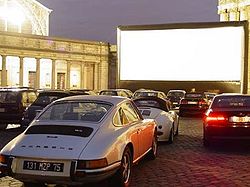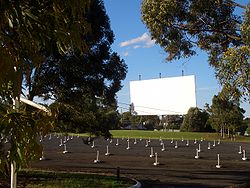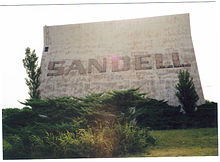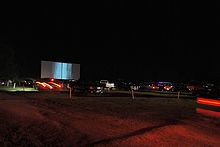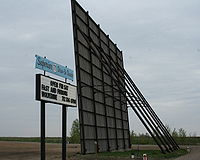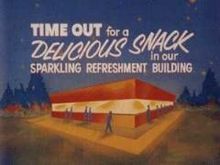- Drive-in theater
-
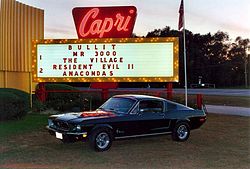 A Bullitt Ford Mustang replica at the Capri Drive In Theater in Coldwater, Michigan, during a showing of Bullitt at their 40th anniversary in 2004
A Bullitt Ford Mustang replica at the Capri Drive In Theater in Coldwater, Michigan, during a showing of Bullitt at their 40th anniversary in 2004
A drive-in theater is a form of cinema structure consisting of a large outdoor screen, a projection booth, a concession stand and a large parking area for automobiles. Within this enclosed area, customers can view movies from the privacy and comfort of their cars.
The screen can be as simple as a wall that is painted white, or it can be a steel truss structure with a complex finish. Originally, a movie's sound was provided by speakers on the screen and later by an individual speaker hung from the window of each car, which would be attached by a wire. This system was superseded by the more economical and less damage-prone method of broadcasting the soundtrack at a low output power on AM or FM Radio to be picked up by a car radio. This method also allows the soundtrack to be picked up in stereo by the audience on an often high fidelity stereo installed in the car instead of monaural through a simple speaker.
Contents
History
The drive-in theater was the creation of Camden, New Jersey, chemical company magnate Richard M. Hollingshead, Jr., whose family owned and operated the R.M. Hollingshead Corporation chemical plant in Camden. In 1932, Hollingshead conducted outdoor theater tests in his driveway at 212 Thomas Avenue in Riverton. After nailing a screen to trees in his backyard, he set a 1928 Kodak projector on the bonnet of his car and put a radio behind the screen, testing different sound levels with his car windows down and up. Blocks under vehicles in the driveway enabled him to determine the size and spacing of ramps so all automobiles could have a clear view of the screen. Following these experiments, he applied August 6, 1932, for a patent of his invention, and he was given U.S. Patent 1,909,537 on May 16, 1933.[1]
Hollingshead's drive-in opened in New Jersey June 6, 1933, on Admiral Wilson Boulevard at the Airport Circle in Pennsauken, a short distance from Cooper River Park.[2][3] It offered 400 slots and a 40 by 50 ft (12 by 15 m) screen.[4][5] He advertised his drive-in theater with the slogan, "The whole family is welcome, regardless of how noisy the children are."[6] The first film shown was the Adolphe Menjou film Wife Beware.[4] The facility only operated three years, but during that time the concept caught on in other states. The April 15, 1934, opening of Shankweiler's Auto Park in Orefield, Pennsylvania, was followed by Galveston's Drive-In Short Reel Theater (July 5, 1934), the Pico in Los Angeles (September 9, 1934) and the Weymouth Drive-In Theatre in Weymouth, Massachusetts (May 6, 1936). In 1937, three more opened in Ohio, Massachusetts and Rhode Island, with another 12 during 1938 and 1939 in California, Florida, Maine, Maryland, Massachusetts, Michigan, New York, Texas and Virginia. Early drive-in theaters had to deal with noise pollution issues. The original Hollingshead drive-in had speakers installed on the tower itself which caused a sound delay affecting patrons at the rear of the drive-in's field. The Pico in drive in 1935 attempted to solve the sound problem, by having a row of speakers in front of the cars with a speaker for each car. But this and other solutions later did of speakers next to the vehicle no matter the location did not produce satisfactory results.[7] In 1941, RCA introduced in-car speakers with individual volume controls which solved the noise pollution issue and provided satisfactory sound to drive-in patrons.[8]
Peak
The Sandell Theater (2000 photograph) off Texas State Highway 70, was a reminder of by-gone days, having closed in 1984. The theater reopened in 2002 in Clarendon, Texas.
The drive-in's peak popularity came in the late 1950s and early 1960s, particularly in rural areas, with some 4,000 drive-ins spreading across the United States. Among its advantages was the fact that a family with a baby could take care of their child while watching a movie, while teenagers with access to autos found drive-ins ideal for dates. Revenue is more limited than regular theaters since showings can only begin at twilight. There were abortive attempts to create suitable conditions for daylight viewing such as large tent structures, but nothing viable was developed.
In the 1950s, the greater privacy afforded to patrons gave drive-ins a reputation as immoral, and they were labeled "passion pits" in the media. During the 1970s, some drive-ins changed from family fare to exploitation films, as a way to offset declining patronage and revenue. In fact some producers in the 1970s would make exploitation films directly for the drive-in market. Also, during the 1970s, some drive-ins began to show pornographic movies in less family-centered time slots to bring in extra income[citation needed]. This became a problem because it allowed for censored materials to be available to a wide audience, some for whom viewing was illegal, and it was reliant upon the whims of local ordinances controlling such material. It also required a relatively remote location distant from populated areas such as towns and cities. This was one aspect of concern about the availability and uncontrollability of adult-centered media in the general public. The drive-in was open to abuse, such as the smuggling in of viewers in the trunks of cars to avoid paying for individual tickets. This had been a common ploy for younger patrons for decades, and eventually led to a per-car admission rate at many locations.
Many drive-ins devised very elaborate and sometimes quirky modes of comfort. Some drive-ins provided small propane heaters, attempting to entice their patrons to come in colder months. Some drive-ins provided a heating or air-conditioning system via underground ducts to heat or cool patrons[citation needed]. Audio systems varied greatly during the era of drive-ins. Some used portable speakers on trucks during the early days but this proved ineffective since the people in the front were blasted with sound while the people in the back could not adequately hear what was being said. One solution came in the form of small speakers which could be hooked onto the side window of the car. These caused damage to the window if one forgot to remove them before driving off, also they had a problem with sound quality and did not provide stereo sound. Later still, as in-car stereos became standard equipment, broadcast of the audio track on particular radio frequencies permitted the most efficient means of delivery.
During their height, some drive-ins used attention-grabbing gimmicks to boost attendance. They ranged from small airplane runways, unusual attractions such as a small petting zoo or cage of monkeys, actors to open their movies, or musical groups to play before the show. Some drive-ins held religious services on Sunday morning and evening, or charged a flat price per car on slow nights like Wednesday. The price was a dollar per car during "buck" nights in the 1950s and 1960s.
Decline
Over time, the economics of real estate made the large property areas increasingly expensive for drive-ins to operate successfully. Land became far too valuable for businesses such as drive-ins, which in most cases were summer-only. Widespread adoption of daylight saving time subtracted an hour from outdoor evening viewing time. These changes and the advent of color televisions, VCRs and video rentals led to a sharp decline in the drive-in popularity. Drive-ins were subject to the whim of nature as inclement weather often caused cancellations. They eventually lapsed into a quasi-novelty status with the remaining handful catering to a generally nostalgic audience, though many drive-ins continue to successfully operate in some areas.
Many drive-in movie sites remain, repurposed as storage or flea markets sites, often after residential housing or other higher value uses came to the lightly populated or unpopulated areas where the drive-ins were located. The largest drive-in theater in the world, the Fort Lauderdale Swap Shop, doubles as the world's largest daily flea market. Former drive-in properties in Michigan, for example, have become industrial parks, shopping centers, indoor theaters, and even churches (as with the Former Woodland Drive-In in Grand Rapids, MI). In Philadelphia, the South City Drive In became the location of the original Spectrum in the late 1960s, with a small portion of its old property line extending into what would become the (now demolished) Veterans Stadium complex. Another example of a drive in-turned-flea market is Spotlight 88 in North Sewickley Township, Beaver County, Pennsylvania, which ended business as a drive-in after an F3 tornado destroyed much of the property on May 31, 1985. As a joke after the tornado hit, the owners put up in the "now-showing" sign Gone with the Wind.
Revival
The year 2001 marked the inception of the "Do-It-Yourself" Drive-In, which utilized contemporary tools such as LCD projectors and micro-radio transmitters. The first was the Liberation Drive-In in Oakland, California, which sought to reclaim under-utilized urban spaces such as vacant parking lots in the downtown area. The following years have seen the rise of the "guerrilla drive-in" movement, in which groups of dedicated individuals orchestrate similar outdoor film and video screenings. Showings are often organized online, and participants meet at specified locations to watch films projected on bridge pillars or warehouses. The content featured at these screenings has frequently been independent or experimental films, cult movies, or otherwise alternative programming. The best known guerilla drive-ins include the Santa Cruz Guerilla Drive-In in Santa Cruz, California, North Bay Mobile Drive-In in Novato, California, MobMov in San Francisco, California and Hollywood, and most recently Guerilla Drive-In Victoria in Victoria, British Columbia.
A pseudo-drive-in has been launched where the cars are provided by the organizer. In the UK the Volvo's urban Starlite Drive-in will be held inside the Truman Brewery in hip East London where the urban population will get the chance to watch classic films in a fleet of convertibles served by roller-skating waitresses.[9]
Faced with the closure of Hull's Drive In in Lexington, Virginia in 1999, the non-profit group Hull's Angels formed to raise funds, buy the property and operate the theater as a non-profit venture specializing in family-friendly films. Hull's continues to be the nation's only non-profit drive in.[10]
As of 2011[update], a figure of 371 drive-ins has been published for the United States, though it is unclear how many of these are traditional versus non-traditional (e.g. guerilla).[11]
Facilities
As with indoor cinemas, the concession stand, also called a snack bar, is where a drive-in earns most of its profits. As a result, much of a drive-in's promotion is oriented toward the concession stand.
The typical snack bar offers any food that can be served quickly, such as hot dogs, pizza, cheeseburgers, popcorn, soft drinks, coffee, hot chocolate, ice cream, candy and french fries. To entice patrons to the concession stands, trailer advertisements called snipes were projected before the feature and during any intermissions.
Some drive-in theater managers added children's playgrounds between the screen and the first row of cars. Others even went as far as adding miniature railroads, merry-go-rounds, and miniature golf courses. Concrete patios for lawn chairs were available at some drive-in theaters, as well as indoor seating for the concession stand. Due to the outdoor setting of drive-in theaters, movies were shown in the evenings.
References
- ^ http://inventors.about.com/library/weekly/aa980121.htm
- ^ Strauss, Robert (July 23, 2004). "The Drive-In Theater Tries a Comeback; Looking for a Few Hundred Adventurous Moviegoers". The New York Times. http://query.nytimes.com/gst/fullpage.html?res=9E0CE0DC163DF930A15754C0A9629C8B63. Retrieved March 26, 2008. "The nation's first drive-in theater was built by the Hollingshead family along the tawdry Admiral Wilson Boulevard in Pennsauken, N.J., in 1933."
- ^ "Movie Theater Lets Cars Drive Right In" Popular Science, August 1933
- ^ a b Lewis, Mary Beth. "Ten Best First Facts". Car and Driver (1/88): 92.
- ^ "Drive-In Movie Holds Four Hundred Cars" Popular Mechanics September 1933
- ^ "This Month in History". Smithsonian. June 2003.
- ^ "Drive-In Theaters Has Speaker For Each Car" Popular Mechanics, October 1935 hand written note by editors to left of archive issue indicates the Pico drive in
- ^ Fielding, Raymond (May 1968). Technological History of Motion Pictures and Television. University of California Press. p. 215. ISBN 978-0520004115. http://books.google.com/books?id=qn6_5XqRXVsC&pg=PA215&dq=%22drive+in+theater%22+%2B+%22in+car+speakers%22+%2B+rca+%2B+1941#.
- ^ Starlite Drive-in
- ^ Philp, Rowan (17 July 2000). "The Best Picture Show; Drive-In Movie Fans Band Together To Keep a Screen From Going Dark". Washington Post. http://pqasb.pqarchiver.com/washingtonpost/access/56467701.html?dids=56467701:56467701&FMT=ABS&FMTS=ABS:FT&type=current&date=Jul+17,+2000&author=Rowan+Philp&pub=The+Washington+Post&desc=The+Best+Picture+Show;+Drive-In+Movie+Fans+Band+Together+To+Keep+a+Screen+From+Going+Dark&pqatl=google. Retrieved 2 November 2010.
- ^ Staff (July/August 2011), "Catch a Sunset Screening", AARP The Magazine (Washington, D.C.): 10, ISSN 1541-9894
Further reading
- "Drive-in" (2001). The Film Encyclopedia, 4th ed., Ephraim Katz (ed). HarperCollins, New York.
- Don Sanders, Susan Sanders, (October 2003) The American Drive-In Movie Theater. Motorbooks International. ISBN 0-7603-1707-0
- Elizabeth McKeon, Linda Everett, Liz McKeon (December 1998). Cinema Under the Stars: America's Love Affair With the Drive-In Movie Theater. Cumberland House. ISBN 1-58182-002-X.
- Sanders, Don and Susan. Drive-in Movie Memories. Middleton: Carriage House, 2000.
- Sanders, Don and Susan. The American Drive-in Movie Theatre. Osceola: Motorbooks International and Wholesalers, 1997.
- Segrave, Kerry. Drive-in Theaters: a History from Their Inception in 1933. Jefferson: McFarland and Company, Inc., 1992.
- "The Drive-in Theater History Page". Drive in Theater. 20 April 2007.
External links
- BBC: "Drive-in theaters refuse to fade away"
- Time Magazine: "Movies that star the stars"
- San Francisco Chronicle: "Reviving drive-in culture"
- "For Drive-In Theaters, an Unexpected Revival", Nancy Mullane, All Things Considered, April 21, 2008.
- A freely downloadable collection of drive-in intermission advertisements
- "Starlit Screens: Preserving Place and Public at Drive-In Theaters," Robin Conner and Paul Johnson, Southern Spaces, October 10, 2008. http://southernspaces.org/2008/starlit-screens-preserving-place-and-public-drive-theaters
- Will the endangered American drive-in fade to black? - CNN
- United Drive-In Theatre Owners Association
- Richard Kuipers' article about Australian Drive-In theatres, and their depiction in Australian films, on australianscreen
Categories:- Drive-in theatres
- Cinemas and movie theaters
- Camden County, New Jersey
- 1932 introductions
Wikimedia Foundation. 2010.

